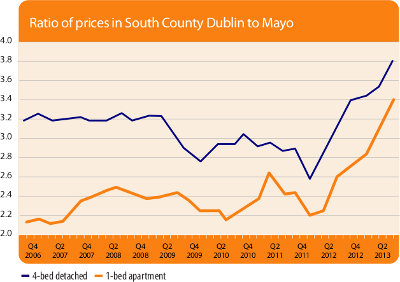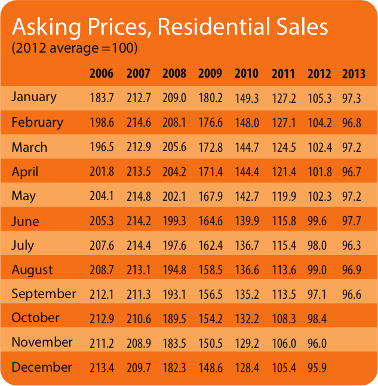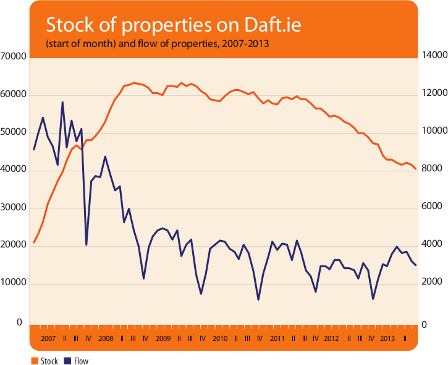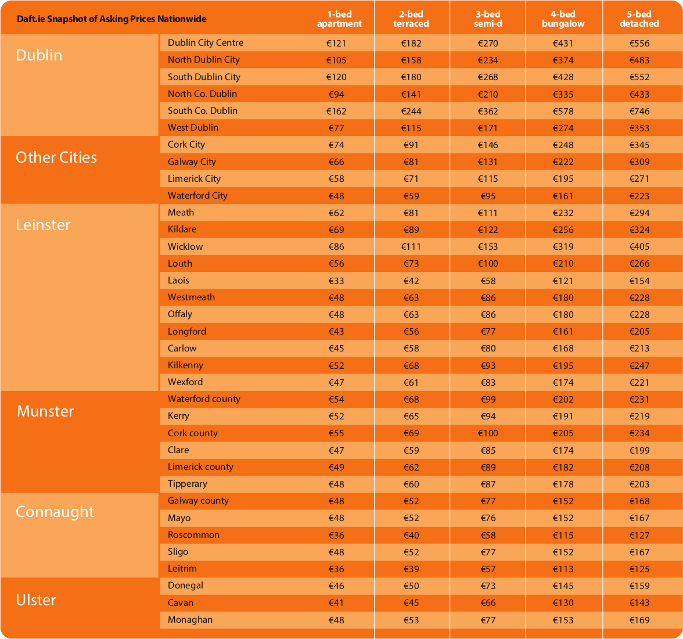Supply shortages, not a new bubble, the concern in Dublin
Daft Reports
- Ronan Lyons (House Price, Q1 2024)
- Ronan Lyons (Rental Price, Q4 2023)
- Ronan Lyons (House Price, Q4 2023)
- Ronan Lyons (Rental Price, Q3 2023)
- Ronan Lyons (House Price, Q3 2023)
- Ronan Lyons (Rental Price, Q2 2023)
- Ronan Lyons (House Price, Q2 2023)
- Ronan Lyons (Rental Price, Q1 2023)
- Ronan Lyons (House Price, Q1 2023)
- Ronan Lyons (Rental Price, Q4 2022)
- Ronan Lyons (House Price, Q4 2022)
- Ronan Lyons (Rental Price, Q3 2022)
- Ronan Lyons (House Price, Q3 2022)
- Ronan Lyons (Rental Price, Q2 2022)
- Ronan Lyons (House Price, Q2 2022)
- Ronan Lyons (Rental Price, Q1 2022)
- Ronan Lyons (House Price, Q1 2022)
- Ronan Lyons (Rental, Q4 2021)
- Ronan Lyons (House Price, Q4 2021)
- Ronan Lyons (Rental, Q3 2021)
- Ronan Lyons (House Price, Q3 2021)
- Ronan Lyons (Rental, Q2 2021)
- Ronan Lyons (House Price, Q2 2021)
- Ronan Lyons (Rental, Q1 2021)
- Ronan Lyons (House Price, Q1 2021)
- Ronan Lyons (Rental, Q4 2020)
- Ronan Lyons (House Price, Q4 2020)
- Ronan Lyons (Wealth, H2 2020)
- Ronan Lyons (Rental, Q3 2020)
- Ronan Lyons (House Price, Q3 2020)
- Ronan Lyons (Housing, July 2020)
- Ronan Lyons (Housing, June 2020)
- Ronan Lyons (Housing, May 2020)
- Ronan Lyons (Rental, Q1 2020)
- Ronan Lyons (House Price, Q1 2020)
- Ronan Lyons (Rental, Q4 2019)
- Ronan Lyons (House Price, Q4 2019)
- Ronan Lyons (Wealth, H2 2019)
- Ronan Lyons (Rental, Q3 2019)
- Ronan Lyons (House Price, Q3 2019)
- Pierre Yimbog (Rental, Q2 2019)
- Ronan Lyons (House Price, Q2 2019)
- Ronan Lyons (Wealth, H1 2019)
- Ronan Lyons (Rental, Q1 2019)
- Ronan Lyons (House Price, Q1 2019)
- Ronan Lyons (Rental, Q4 2018)
- Ronan Lyons (House Price, Q4 2018)
- Ronan Lyons (Wealth, H2 2018)
- Ronan Lyons (Rental, Q3 2018)
- Ronan Lyons (House Price, Q3 2018)
- Shane De Rís (Rental, Q2 2018)
- Ronan Lyons (House Price, Q2 2018)
- Ronan Lyons (Wealth, 2018)
- Ronan Lyons (Rental, Q1 2018)
- Ronan Lyons (House Price, Q1 2018)
- Ronan Lyons (Rental, Q4 2017)
- Ronan Lyons (House Price, Q4 2017)
- Ronan Lyons (Rental, Q3 2017)
- Ronan Lyons (House Price, Q3 2017)
- Katie Ascough (Rental, Q2 2017)
- Ronan Lyons (Wealth, 2017)
- Ronan Lyons (House Price, Q2 2017)
- Ronan Lyons (Rental, Q1 2017)
- Ronan Lyons (House Price, Q1 2017)
- Ronan Lyons (Rental, Q4 2016)
- Ronan Lyons (House Price, Q4 2016)
- Ronan Lyons (Rental, Q3 2016)
- Ronan Lyons (House Price, Q3 2016)
- Ronan Lyons (School Report, 2016)
- Conor Viscardi (Rental, Q2 2016)
- Ronan Lyons (Rail Report, 2016)
- Ronan Lyons (House Price, Q2 2016)
- Ronan Lyons (Rental, Q1 2016)
- Ronan Lyons (House Price, Q1 2016)
- Ronan Lyons (Rental, Q4 2015)
- Ronan Lyons (House Price, Q4 2015)
- Ronan Lyons (Rental, Q3 2015)
- Ronan Lyons (House Price, Q3 2015)
- Marcus O'Halloran (Rental, Q2 2015)
- Ronan Lyons (House Price, Q2 2015)
- Ronan Lyons (Rental, Q1 2015)
- Ronan Lyons (House Price, Q1 2015)
- Ronan Lyons (Rental, Q4 2014)
- Ronan Lyons (House Price, Q4 2014)
- Ronan Lyons (Rental, Q3 2014)
- Ronan Lyons (House Price, Q3 2014)
- Domhnall McGlacken-Byrne (Rental, Q2 2014)
- Ronan Lyons (House Price, Q2 2014)
- Ronan Lyons (Rental, Q1 2014)
- Ronan Lyons (House Price, Q1 2014)
- Ronan Lyons (Rental, Q4 2013)
- Ronan Lyons (House Price, Q4 2013)
- Ronan Lyons (Rental, Q3 2013)
- Ronan Lyons (House Price, Q3 2013)
- Ronan Lyons (Rental, Q2 2013)
- Ronan Lyons (House Price, Q2 2013)
- Ronan Lyons (Rental, Q1 2013)
- Ronan Lyons (House Price, Q1 2013)
- Ronan Lyons (Rental, Q4 2012)
- Ronan Lyons (House Price, Q4 2012)
- Lorcan Sirr (Rental, Q3 2012)
- Padraic Kenna (House Price, Q3 2012)
- John Logue (Rental, Q2 2012)
- Ronan Lyons (House Price, Q2 2012)
- Barry O'Leary (Rental, Q1 2012)
- Seamus Coffey (House Price, Q1 2012)
- Joan Burton (Rental, Q4 2011)
- Ronan Lyons (House Price, Q4 2011)
- Philip O'Sullivan (Rental, Q3 2011)
- Sheila O'Flanagan (House Price, Q3 2011)
- Rachel Breslin (Rental, Q2 2011)
- Constantin Gurdgiev (House Price, Q2 2011)
- Cormac Lucey (Rental, Q1 2011)
- Eoin Fahy (House Price, Q1 2011)
- Lorcan Roche Kelly (Rental, Q4 2010)
- Ronan Lyons (House Price, Q4 2010)
- John Fitzgerald (Rental, Q3 2010)
- Patrick Koucheravy (House Price, Q3 2010)
- Gary Redmond (Rental, Q2 2010)
- Jim Power (House Price, Q2 2010)
- Jill Kerby (Rental, Q1 2010)
- Brian Lucey (House Price, Q1 2010)
- Michael Taft (Rental, Q4 2009)
- Alan McQuaid (House Price, Q4 2009)
- Dr. Charles J. Larkin (Rental, Q3 2009)
- Emer O'Siochru (House Price, Q3 2009)
- Ronan Lyons (Rental, Q2 2009)
- Oliver Gilvarry (House Price, Q2 2009)
- Brian Devine (Rental, Q1 2009)
- Dr. Liam Delaney (House Price, Q1 2009)
- Gerard O'Neill (Rental, Q4 2008)
- Ronan Lyons (House Price, Q4 2008)
- Dr. Stephen Kinsella (Rental, Q3 2008)
- Moore McDowell (House Price, Q3 2008)
- Shane Kelly (Rental, Q2 2008)
- Fergal O'Brien (House Price, Q2 2008)
- Eoin O'Sullivan (Rental, Q1 2008)
- Dermot O'Leary (House Price, Q1 2008)
- Dan O'Brien (Rental, Q4 2007)
- Frances Ruane (House Price, Q4 2007)
- John McCartney (Rental, Q3 2007)
- Ronnie O'Toole (House Price, Q3 2007)
- Ronan Lyons (Rental, Q2 2007)
- Constantin Gurdgiev (House Price, Q2 2007)
- Fintan McNamara (Rental, Q1 2007)
- Rossa White (House Price, Q1 2007)
- Geoff Tucker (Rental, Q4 2006)
- Damien Kiberd (House Price, Q4 2006)
- Pat McArdle (House Price, Q3 2006)
- Marc Coleman (House Price, Q2 2006)
- David Duffy (House Price, Q1 2006)
- Austin Hughes (House Price, Q4 2005)
- David McWilliams (House Price, Q2 2005)

1st Oct 2013
Ronan Lyons, Daft's in-house economist, commenting on the latest Daft research on the Irish property market.
Supply shortages, not a new bubble, the concern in Dublin
As we enter the final quarter of 2013, the signals emerging from the housing market have totally changed compared to two years ago. Then, it seemed there was no end to falls in house prices, particularly in Dublin, which at that point had seen asking prices fall 55% from the peak compared to 48% elsewhere.
Now however, even as asking prices continue to fall outside the capital, and at double-digit rates in Munster, there are concerns about a new bubble emerging in Dublin. Such concerns are probably overstated - ultimately bubbles can only emerge with loose credit, and there are few who would argue that the housing market in Dublin is cursed with easy money.
Instead, what we are witnessing is something like the lancing of a boil. For almost five years, a significant chunk of would-be first-time buyers based in Dublin held off making a purchase, enjoying not only falling prices while they did but falling rents for the early years also. And they saved. Then, probably due to a combination of the end of mortgage interest relief, rising rents and starting their own families, they started to buy.
But this backlog of buyers is not limitless. They are two-job couples, working in FDI sectors or related professional services. They have secure incomes and are, for the want of a better word, the darlings of the mortgage market currently. It is this backlog that we are currentlywitnessing driving in the market. And markets being markets, there is probably an element of momentum emerging, with other transactions occurring as people get caught up in the rush.
The problem for policymakers therefore is not another bubble - it's a scarcity of houses in areas where people want to set up homes. It does not take an economist to point out that jobs are scarce currently and what jobs are being created at the moment are being created disproportionately in Ireland's cities, particularly in Dublin. This is shifting demand towards the capital.
Six months ago, my commentary to the Q1 Report presented figures for the average four- bedroom detached house and one-bedroom apartment in South County Dublin and in Mayo. I mentioned at the time that the ratio of prices between the two areas would be a good signal of pressures in the market. The ratio for both properties is shown in the graph (overleaf ). The trend over the last six months is every bit as dramatic as what preceded it: if prices can act as a warning signal, this is the alarm bell ringing.

Figure: Ratio of prices in South County Dublin to Mayo
Intricately tied up with the shift in prices towards Dublin is the issue of supply. Not only has Dublin almost no backlog from the bubble years, it is also building next to no new homes. A city of almost half a million households is building only slightly more than 1,000 units a year. This is probably one tenth of the number of new homes it needs: available figures suggest that there are about 10,000 first-time mothers in Dublin each year.
Bizarrely, when the topic of new supply is raised, a common response is: "We don't want another bubble." The whole point about bringing new supply of homes is to prevent prices from rising to unaffordable levels, not cause it. As mentioned above, supply of credit increases house prices; supply of dwellings lowers them.
The findings from this report are stark. For the first time since 2007, each of the six regions of Dublin covered in the Daft.ie Report now shows asking prices rising in year-on-year terms. Every single other region in the country shows them still falling. While year-on-year inflation in the capital will ease over the next 6 months, as the last quarters of falling prices fall out of the equation, this should not be taken as the problem going away.
Ultimately, housing near centres of employment needs to be affordable. This sounds like a tall order for Government, something perhaps impossible to get right through tinkering with the market. Policymaking is as much about diagnosis as anything else. Thus, for policymakers, a logical place to start addressing this issue is establishing why builders are currently not building.
Future Daft.ie Reports will be publishing more price per square metre information. Hopefully, this will contribute to be a better understanding of this key metric of the market and with better informed consumers, we are less likely to fall into so severe a bubble as the one we are still recovering from.
HIGHLIGHTS:
Asking Prices, Residential Sales

Stock and Flow of Sale Properties
SNAPSHOT:

Snapshot of Asking Prices Nationwide
